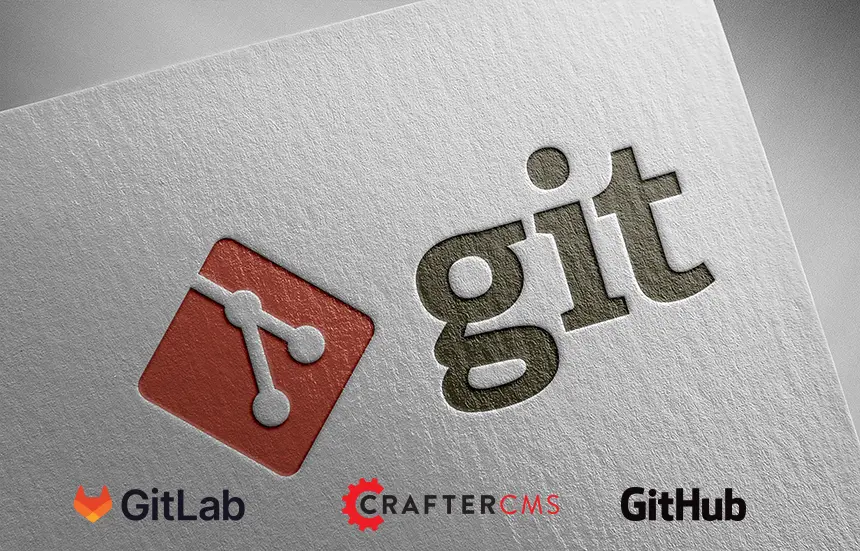Git vs GitHub vs Gitlab

Mike Vertal

Effective collaboration is a critical component of any successful enterprise business. With multiple employees creating their own versions of important files and working across various teams, having a way to organize multiple versions, merge changes, introduce version rollbacks from backups and quickly identify where issues went wrong is critical.
A reliable version control system can help businesses accomplish all of this, particularly when working with content assets. In the modern software development environment, three terms that are often used in relation to version control are Git, GitHub, and GitLab.
This article will shed some light on Git, GitHub, and Gitlab, explain each of these terms and dive into some of the differences between them. We’ll also highlight how a Git-based platform like CrafterCMS can be a game changer in content management today.
What Is Git?
Git is an open source distributed version control system. Developers across the world leverage Git for collaboration on projects as it enables them to store code and configuration files, merge changes, track version history and revert to previous versions of code if necessary.
Files stored locally in a Git repository, allowing you to create a copy. This copy is known as a branch, enabling you to work in parallel with the main version of your source files. Commit changes made to the branch, and then you can merge those changes with the main branch.
The ability to create branches and track the changes made to the main version of your source code over time is one of the primary benefits of Git and why it’s critical to successful software development.
Whereas Git is a version control system that is available to download and use as a library, GitHub and GitLab are both platforms that leverage Git and its version control capabilities to provide “Git as a service” for software development departments, software enterprises, and open source projects. (Similar to how GitHub and GitLab utilize Git for source code management, CrafterCMS utilizes Git as its embedded repository for content management.)
Read More: What Is a Git-based CMS?
What Is GitHub?
GitHub is a Microsoft-owned, cloud-based Git hosting service. It enables communication and collaboration between developers and allows them to track their code and monitor changes made. Due to its extensive features, GitHub makes it easy for developers to leverage Git for version control.
Developers of all skill levels can work using GitHub, and it is particularly popular with open source projects as public code can be hosted in the repository for free. However, for a fee, companies can also use GitHub to host their own private repositories.
In addition, GitHub has added features to make itself a complete developer platform. For example, Codespaces offers a cloud-based development environment. Github also provides a service called Github Pages, for hosting static website files.
What Is GitLab?
GitLab is a cloud-based Git repository and DevOps platform that enables developers to monitor, test and deploy code. Initially seen as an alternative to GitHub, GitLab now offers several DevOps features, including app deployment tools, security, CI/CD, and more.
GitLab supports development teams throughout the entire DevOps lifecycle and enables DevOps teams to deliver software faster.
Similarities Between GitHub and GitLab
Since GitHub and GitLab are competing services built on Git, the two platforms have a few notable similarities.
Git, CI/CD, access to documentation, the ability to preview code changes and review code, issue and time tracking, load and browser performance testing, as well as iterations and sprint planning are some of the common features that can be found across both platforms.
While these features are all available in GitLab, GitHub users need to leverage a third-party app to access features like time tracking, load performance testing, and continuous integration and delivery.
Both platforms also use the typical Git commands and functionality.
- Branch: Create an independent branch or development line.
- Fork: Create a personal copy of a code repo. Changes made to the code in the fork can then be merged later.
- Pull: GitHub’s pull requests allow developers to submit changes to the primary code branch. In GitLab, they are known as merge requests but are the same action.
Key Differences Between GitHub and GitLab
Despite the similarities between the two platforms, there are some key differences that organizations should be aware of.
Size of the Community
As an older platform, GitHub remains the most popular Git repository. There are far more long-term users who are familiar with GitHub and willing to publish their public code there instead. Several open source projects, in particular, will typically share a link to their public repository for anyone to access the code.
Continuous Integration
As GitLab has prioritized being a complete DevOps platform, it has emphasized the importance of CI/CD. With GitHub, CI/CD features are only available via a third-party app. However, with GitLab, you can build and deploy code without needing manual updates or integrations.
Open Source
Despite both platforms readily supporting open-source projects, GitLab’s project is licensed as open source, while GitHub is proprietary.
Pricing
The pricing structures on GitHub and GitLab are quite different and can be difficult to compare for individual users and enterprises. Both offer free plans with unlimited repositories, but their paid plans for enterprises are distinct.
GitHub’s Team plan starts at $4/user/ month, while their enterprise plan begins at $21/user/month. Meanwhile, GitLab’s Premium plan is priced at $19/user/month, and their enterprise plan stands at $99/user/month.
CrafterCMS: A Modern Git-based CMS
Like Github and Gitlab, CrafterCMS leverages Git as its underlying repository. Unlike Github and Gitlab, however, CrafterCMS stores and manages all content-related files – in addition to code and configuration if desired – in its underlying Git-based content repository. Unlike Github Pages, CrafterCMS does not just store static HTML files. Instead, CrafterCMS stores and manages all types of content files - XML, CSS, Javascript, Groovy scripts, documents etc. - related to any type of dynamic digital experience using its embedded Git-based content repository.
Even better, developer and DevOps teams can use their favorite Git-based source code control system (e.g., GitHub or GitLab or others) and easily build and deploy content-based software applications (websites, intranets, mobile apps, portals, e-commerce, etc.), and collaborate seamlessly with the content teams using the Git-based CrafterCMS.
Whether you prefer to use GitHub or GitLab is up to the needs of your software development and IT teams. However, when it comes to content management, the benefits of Git can be leveraged for all content assets as well by the content authors.
With WYSIWYG editing, In-Context Preview, and drag and drop experience building, and more, marketers and other business users benefit from CrafterCMS’s powerful content authoring capabilities, along with the multi-file versioning, auditing, branching, workflow and security features that Git provides without knowing how Git works.
In addition, CrafterCMS adds the benefits of DevOps support for content-driven applications through its unique DevContentOps approach. Using DevContentOps, software development, IT, and content teams can collaborate to publish new content and/or software feature updates on a continuous basis, provide engaging customer experiences, and deliver new capabilities without delays.
Learn about the benefits of Git and DevContentOps in our White Paper: Five Reasons Why You Should Use A Git-Based CMS.
Related Posts

How Should You Structure a Blog Post So AI Models Actually Cite It?

Amanda Jones

Publishing Content from Crafter Studio to External Systems and Databases

Sara Williams

Websites Are Dead?

Mike Vertal

No-Code Experience Building for Marketers & Designers

Amanda Lee










